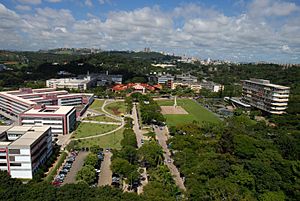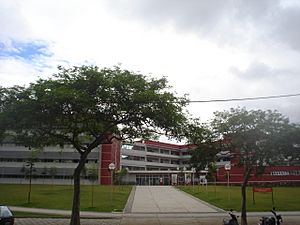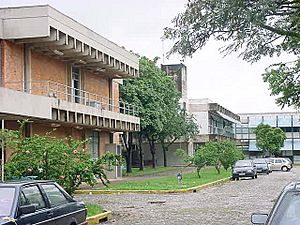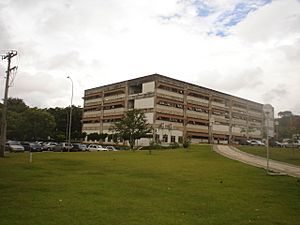Federal University of Minas Gerais facts for kids
|
Universidade Federal de Minas Gerais
|
|
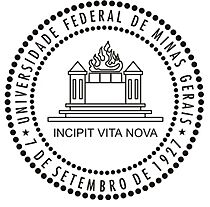 |
|
|
Other names
|
UFMG |
|---|---|
| Motto | Incipit Vita Nova (Latin) |
|
Motto in English
|
A new life begins |
| Type | Public university |
| Established | 7 September 1927 |
| Endowment | R$2,510,329,556 (2025) |
| Rector | Sandra Regina Goulart de Almeida |
|
Administrative staff
|
4,445 |
| Undergraduates | 30,957 (in 2010) |
| Postgraduates | 14,838 (in 2010) |
| Location | , , |
| Campus | Urban, 8,794,767 square meters (2,173.234 acres) |
| Website | www.ufmg.br |
 |
|
The Federal University of Minas Gerais (called UFMG for short) is a major public university in the state of Minas Gerais, Brazil. A public university is funded by the government, so students can attend at a lower cost. UFMG is known for being a research university, which means its professors and students are always working on new discoveries.
Its main campus is in the city of Belo Horizonte. UFMG is one of the biggest and best universities in Brazil. It is often ranked as one of the top five universities in all of Latin America.
Students can choose from 79 different subjects to study for their first degree. The university also offers many advanced programs for students who want to continue their education, like master's and doctoral degrees. Most classes are taught at the huge Pampulha campus in Belo Horizonte.
Contents
History of the University
The story of UFMG began a long time ago, even before it was officially a university. In the late 1800s, a few schools for higher education were opened in the state of Minas Gerais.
In 1898, the Faculty of Law in the city of Ouro Preto moved to Belo Horizonte. Over the next few years, more schools opened, like a School of Dentistry in 1907 and a School of Medicine in 1911.
These separate schools were not yet connected. In 1927, four of these schools joined together to create the University of Minas Gerais (UMG). At first, it was a private university that received money from the state government.
In 1949, the national government of Brazil started to fund the university. It officially became the Federal University of Minas Gerais, or UFMG, in 1965. In the 1960s, the university began building its main campus in an area called Pampulha, which is where most students go today.
What It's Like at UFMG
UFMG is like a small city. Over 70,000 people study and work there. This includes undergraduate students, graduate students, professors, and staff.
The main campus in Pampulha is very large, with a total area of over 8.7 million square meters. Besides classrooms and labs, the campus has its own parks and museums. There is even a large forest area called the "Ecological Station." Scientists study the unique plants and animals that live there.
Outside of Belo Horizonte, UFMG has other campuses. There is one for farming sciences in Montes Claros and a cultural campus in the historic city of Tiradentes.
Getting into UFMG is very competitive. Students from all over Brazil take a national exam to try to get a spot. For every 100 students who apply, only about 6 are accepted.
What Can You Study?
UFMG is made up of many different schools and institutes, each focusing on certain subjects. Students can study almost anything they can imagine.
Arts and Design
The School of Architecture was the first of its kind in Brazil to be separate from engineering or fine arts. The School of Fine Arts offers classes in painting, animation, and digital arts. At the School of Music, students can learn to play instruments, sing, or become composers.
Sciences
The Exact Sciences Institute is for students who love math, computers, and science. It has courses in Computer Science, Physics, and Chemistry. The Biological Sciences Institute is where students study living things, from tiny cells to entire ecosystems.
Health and Medicine
UFMG is famous for its health programs. The Faculty of Medicine is one of the best in the country. The university has its own large hospital where students learn and doctors conduct research. The School of Veterinary Medicine has a hospital that treats animals from all over Brazil, including those from zoos. Students can also study Dentistry, Nursing, and Pharmacy.
Humanities and Social Sciences
The Faculty of Philosophy and Human Sciences (FAFICH) is one of the oldest parts of the university. Here, students can study subjects like History, Sociology (the study of society), and Psychology. The Faculty of Law is also very famous and is located in its own building in downtown Belo Horizonte.
Cool Discoveries and Research
Because UFMG is a research university, its teams are always working on exciting projects.
- Health Discoveries: Scientists at the Institute of Biological Sciences have created new vaccines, including one for a disease called American visceral leishmaniasis. They also developed a simpler way to study DNA.
- Engineering Projects: The School of Engineering works on new technology. They study how to protect buildings from lightning and how to use solar power to create clean energy.
- Animal Care: The Veterinary School is a leader in animal science. It has two large experimental farms and a modern hospital for animals.
- Protecting Nature: The university's Ecological Station on campus is a protected forest. It's the largest green area in the city and is home to many rare insects and animals that researchers study.
Famous People from UFMG
Many important and famous people have studied at UFMG.
- Presidents of Brazil: Dilma Rousseff and Juscelino Kubitschek both attended the university.
- Writers and Artists: The famous writer João Guimarães Rosa and the poet Carlos Drummond de Andrade were students here.
- Musicians: Samuel Rosa, the lead singer of the band Skank, and Fernanda Takai from the band Pato Fu also went to UFMG.
See also
 In Spanish: Universidad Federal de Minas Gerais para niños
In Spanish: Universidad Federal de Minas Gerais para niños
- Brazil University Rankings
- List of federal universities of Brazil
- Minas Gerais State University
- Universities and Higher Education in Brazil


